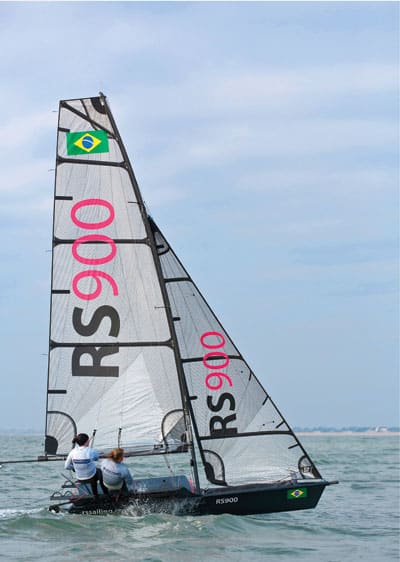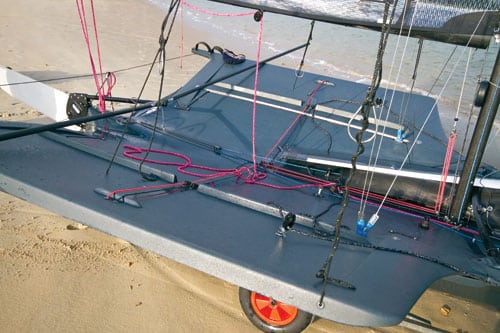
RS900
After years as a male-dominated domain, skiff sailing is set to fully open its doors to women. In 2011 the International Sailing Federation confirmed the addition of a women’s skiff to the docket for the 2016 Olympics. As this issue is reaching our readers, the six contending designs are being put on trial in Santander, Spain. A full trials report will be delivered at the ISAF’s mid-year meeting in May in Italy, and the winning boat will be selected at the annual meeting in November.
The opportunity for a sneak preview of RS Sailing’s entry—the RS900—was enough to convince three top women’s dinghy sailors to brave a freezing cold English winter’s day at Hayling Island Sailing Club.
The RS900 is a development of the successful RS800. There is a family resemblance, but the 900 is shorter, lower, and lighter than the 800, and has solid wings and a modern rig profile. “Our vision is for a women’s skiff that is truly the equivalent of the 49er,” says RS Technical Director Alex Newton-Southon.
A view from the beach
The hull, wings, and foils are glass/foam/epoxy for optimum longevity. The hull weighs 121 pounds, not including the wings, which connect to the hull to form a continuous and rigid deck structure when sailing. They are removable by undoing a pair of bolts on each side.
There is neat detailing in the bow area, too: the nylon pole collar incorporates the forestay fitting, and is secured from below leaving a perfectly smooth opening for the asymmetric spinnaker, with no need for plastic tape.
The cockpit/wing area is strikingly uncluttered: the mainsheet is an aft bridle system with the final lead forward on the boom, while vang and cunningham controls cleat on the gunwhale mid-cockpit.

The helm’s trapeze and the kite sheet turning blocks are in the middle of the wing, with crew’s trapeze forward on the outboard edge of the wing, giving a good lead, with trapeze hooks coming nicely to hand in trapezing conditions. It will also require the crew trapeze wire to be led around the outside of the shrouds, 49er style, in light winds.
The jib uses a standard “track and pin” self-tacking system, with the sheet led back to a swivel cleat mid-cockpit. A single line, cleated aft of the mast, hoists the spinnaker and extends the pole.
The mast, a carbon Selden 064 section, is stiffer than rigs found on other skiffs of this size, with the aim of keeping tuning simple. It separates into two pieces to facilitate transport.
Shrouds, cap shrouds, forestay, and lowers are terminated in vernier adjusters. Coarse tuning is achieved through mast rake, with cap shroud tension controlling gust response.
The sail plan has far more pleasing proportions than the RS800. It has a bigger jib, tacked at the bow; a lower, square-top main; and a 280-square-foot masthead kite. That ensemble should provide enough power to give two women the same level of entertainment when sailing in the same conditions as the guys in their 49ers.
“When we took the RS800 to Hyères four years ago for the original trials, we all felt it looked too big for the girls,” says Newton-Southon. “That’s where our design process began: a proportionally smaller platform, taking into account the sailors’ needs regarding weight, size, and strength. We wanted the 900 to power up and plane at similar wind speeds to the men’s skiff. To do this we kept sail area up, but minimized the height of the center of effort: hence the jib tack on the bow, and the relatively low boom.”
A view from the chase boat
The two-sail reach is the bête-noire of many skiff sailors. But the long reach to the bay from HISC immediately demonstrated one of the benefits of wings versus racks. The sailors looked very comfortable standing mid-rack ready to react to gusts or lulls. In 9 to 13 knots, the 900 showed no tendency to nosedive.
“We didn’t want to intimidate the girls,” says Newton-Southon. “Some countries will be coming into this sport with limited skiff experience. We did not want as hairy a ride as the 49er. We reduced the buoyancy at the back of the boat and, evened out the rocker line, significantly reducing nose diving tendencies.”
Our test team was toward the top of the 240- to 285-pound target weight range for the boat. But they were able to power up while going upwind by easing vang and cunningham to maintain flat wiring—trapezing at full stretch—through the lulls.
At the top end of our wind range, increasing vang and cunningham kept the boat accelerating with boom inside the quarter. The freeboard is low, but the wings are angled upward enough to allow the boat to be sailed dead upright, even with sailors trapezing low. The narrow hull tracked over the waves and through the chop with ease.
At one point during the test, when the sailors failed to spot an oncoming lull, the boat rolled to windward far enough for the wings to hit the water. The buoyancy from the wing provided just enough extra stability to avoid a death roll.
The increased jib size, and crew-led mainsheet makes tacking the RS900 straightforward. When the boats start racing, the primary question heading into a tack won’t be “Will we make it?” but rather “How well can we do it?” This should produce good tactical racing. If the boat heels too much before the sailors cross the boat, however, it’s an uphill climb with no footholds.
With the spinnaker flying, the RS900 sailed comfortably at wind speed. At the lower wind strengths, steering to maintain apparent wind over the waves was the winning technique. The best VMG was achieved by flat-wiring with the rig fully powered up. With helm and crew hooked into the foot loops, the ride over waves in moderate winds looked both exhilarating and fluid.
As with any asymmetric kite, the best jibes were those done with the boat at maximum speed. In our testing conditions, the buoyancy in the wings did give a little extra margin in a slow speed jibe. At 20 knots, flat-out will be only one way to jibe.
We found it hard to find fault with the RS900: our day watching the girls put the RS900 through its paces had us wishing we had brought our sailing gear. It certainly ticks all the boxes. It has enough power to keep it interesting, and enough stability to provide great racing in the full range of conditions. Additionally, it’s backed up by a world-class builder/supply chain. But as all Olympic sailors know, anything can happen at a sudden-death equipment trial.
RS 900 Vital Statistics
Construction: epoxy foam sandwich
LOA 15’4″
LWL 14’9″
Beam 9’3″
Draft 4’9″
Hull weight 121 lbs.
(not includng wings)
Mainsail 127 sq. ft.
Jib 65 sq. ft.
Kite 286 sq. ft.
Spars Selden carbon
Testers’ views upwind
“Sailing at 286 pounds felt good: we certainly didn’t feel too heavy. I often feel too big in the 29erXX in light winds, but still too small in the strong winds. The RS900 seems less weight sensitive.
“It’s really smooth upwind. I think you can do more with the trim than the XX. And the high wings mean you can trapeze really low without hitting the water.”
—29erXX sailor Hanna Klinga, 22, of Sweden
“We weren’t sure how to set up the square top. We maybe had a little too much vang, but once in the groove it felt like we could steer through a nice wide angle. The 900 responded well to fore and aft movement: forward in the light and flat water, aft in the pressure and waves. Upwind we didn’t change anything, just looked around and suddenly realized that we were going quite fast.”
—RS800 sailor Hannah Diamond, 22, of Great Britain
**Downwind **
“It feels light, fast, and rewarding, with lots of feedback compared with the 800. I think that’s what the girls are looking for.
“We had to steer around the waves quite a lot, so it was good to lock into the foot loops. It didn’t feel like we needed to be that far back, but locking in made it much easier to helm.” —H.D.
The maneuvers
“It is nowhere near as unstable as I expected. It’s quite easy to sail, really: the skill will be in sailing faster. Obviously, our boat handling was not up to scratch but we never felt like we were close to capsizing. I like that you don’t need to think about where you put your feet.”
—470 skipper Sophie Ainsworth, 22, of Great Britain
Lasting impressions
“It looks sleek and is great fun. It is nice that it is designed specifically for girls. It’s very different sailing to the 470; it will be a challenge to learn a new style. But not a problem, if you put in the hours on the water.” —S.A.
The competition
The selection Trials for the women’s skiff and the mixed (aka coed) multihull for the 2016 Olympics in Rio de Janeiro were scheduled for March 17 to 25 in Santander, Spain. The boats that have been submitted for consideration include the following skiffs: 29erXX, ARUP Skiff, AURA, Hartley Rebel, Mackay FX, and the RS900. The multihulls that will vie for the coed multihull Olympic berth are: Hobie 16, Hobie Tiger, Nacra 17, Nacra F16, Spitfire S, Tornado, and Viper.









